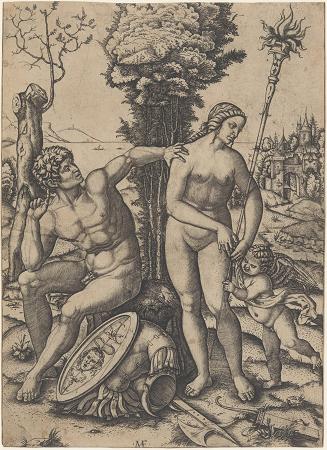Cupid / Eros. In classical mythology, Cupid is the god of desire, erotic love, attraction and affection. Cupid is typically portrayed in art as a young, winged boy or cherub, often depicted with a bow and arrows. His arrows symbolize his power to make people fall in love, and he is frequently shown aiming or shooting these arrows. In many artworks, Cupid is also portrayed as playful and mischievous, reflecting his role in stirring both romantic and chaotic emotions. In classical and Renaissance art, Cupid is often depicted nude or partially clothed, with soft, round features and a youthful, innocent appearance. He sometimes appears with his mother, Venus / Aphrodite, or in scenes of lovers, symbolizing his role in bringing them together. In some representations, Cupid is blindfolded, symbolizing the irrationality and unpredictability of love. In Baroque and later periods, Cupid’s image evolved, often becoming more playful, mischievous, or even symbolic of eroticism. For example, in works by artists like Caravaggio and Rubens, he is shown interacting with humans or gods in ways that emphasize the transformative or disruptive nature of love. Cupid's depiction continues to evolve in modern and contemporary art, but he remains a central symbol of love, desire, and the capriciousness of emotion. Although Eros is generally portrayed as a slender winged youth in Classical Greek art, during the Hellenistic period, he was increasingly portrayed as a chubby boy. During this time, his iconography acquired the bow and arrow that represent his source of power: a person, or even a deity, who is shot by Cupid's arrow is filled with uncontrollable desire. In myths, Cupid is a minor character who serves mostly to set the plot in motion. He is a main character only in the tale of Cupid and Psyche, when wounded by his own weapons, he experiences the ordeal of love. Although other extended stories are not told about him, his tradition is rich in poetic themes and visual scenarios, such as Love conquers all and the retaliatory punishment or torture of Cupid. In art, Cupid often appears in multiples as the Amores, or amorini in the later terminology of art history, the equivalent of the Greek erotes. Cupids are a frequent motif of both Roman art and later Western art of the classical tradition. In the 15th century, the iconography of Cupid starts to become indistinguishable from the putto. Cupid continued to be a popular figure in the Middle Ages, when under Christian influence he often had a dual nature as Heavenly and Earthly love. In the Renaissance, a renewed interest in classical philosophy endowed him with complex allegorical meanings. In contemporary popular culture, Cupid is shown drawing his bow to inspire romantic love, often as an icon of Valentine's Day. The Romans reinterpreted myths and concepts pertaining to the Greek Eros for Cupid in their own literature and art, and medieval and Renaissance mythographers conflate the two freely. In the Greek tradition, Eros had a dual, contradictory genealogy. He was among the primordial gods who came into existence asexually; after his generation, deities were begotten through male-female unions. In Hesiod's Theogony, only Chaos and Gaia are older.
more...














